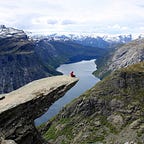A Bit of the Netherlands in Western Canada
An ecological reserve built by Dutch émigrés
It was a cloudy weekend on a typical Vancouver day and the question — again typical Vancouver — was where do we hike tomorrow. The solution, and there is no shortage of them in this beautiful region, was Pitt Polder Ecological Reserve for a healthy dose of history and nature.
On the road to Pitt Meadows, east of Vancouver a few cars headed in the same direction as us carrying a canoe on the roof. Driving past berry farms, we saw ditches on either side of the road with a drainage system to ensure that water was constantly pumped out. Without them, many houses and farms risk getting submerged.
The mountains all around were shrouded in white clouds as we crossed the narrow Alouette river. While entering the parking lot, I noticed the cars with the canoes had picked the same destination and soon I would realise why.
History of Pitt Polder
The Netherlands, as its name suggests in several languages (Pays-Bas in French, Paises Bajos in Spanish), is a low-lying country. Around 17% of its territory lies below sea level on reclaimed land called polders. Jan Blom, an enterprising Dutchman arrived here in the 1940s after World War II and noticed that Chinese railway workers had already built a dyke here in 1911 before the first war. Coming from a country established on reclaimed land, he saw potential here, returned home and found a group of friends with whom he bought the land for next to nothing as it was a wetland.
In the 40s and 50s, they built several dykes in the bog with funding from a company set up under the name Pitt Polder Ltd. and some Canadian investors. Later on, residents of neighbouring Pitt Meadows contributed as well. The result of all this work and later developments is the Ecological Reserve we can visit today.
Just like Jan Blom, who first explored the region by canoe, more and more visitors showed up with their boats and went off to explore the park. We, on the other hand had to depend on our feet for the canoe rental at the entrance of the main dyke was closed presumably due to the COVID-19 pandemic.
The wide dyke past the boating jetty bordered Pitt Lake on the left and a bog overgrown with water lilies and other vegetation on the right. Green mountains framed the entire setting. With so much water around, the reserve is a paradise for birds, and therefore birdwatchers. I spotted seagulls, an osprey, a painted blue heron, ducks and national bird — the Canada goose. The park also attracts deer and black bears. The trail is punctuated by wooden viewpoints, two of which I climbed to admire the landscape.
All this water makes this the ideal habitat of another national symbol. Beaver lodges resembling mounds of mud and wood protruded from the marsh. The national animal of Canada proved that it was not going to be outdone by the Dutch settlers in dam building.
We turned right at the end of the wide path to enter a narrower trail called Swan dyke. Brown reeds and pink flowers lined the grassy path while ducks quacked about in the water on either side. The trail led right to another viewpoint before which I saw a statuesque blue heron staring quietly into the horizon next to a beaver’s lodge.
The mirador had some plaques with details and pictures about the birds of the region. It’s a shame that they were black and white illustrations with descriptions of flora and fauna like blue herons and red-tailed hawks. Nonetheless, they provided some useful information and the watchtower offered a great view of the park.
The rest of the trail was narrow and ovegrown with thorny blackberry brambles. I had my share of plump ripe berries but the bushes seemed to take revenge on me as I kept getting caught in all the thorns. A few visitors were fishing discreetly from their inflatable boats and foldable seats. We were soon back at the parking lot. The day was young so we decided to visit another park.
Just as we were entering the main road, I saw a big orange sign that read “Amsterdam”. It was a huge nursery and gardening shop. After all these years, there’s still a bit of the Netherlands in this part of the world.
Beside still waters
We drove west towards Port Coquitlam and arrived at Minnekhada Park. The name meaning “beside still waters” in the Sioux language is apt since the park is essentially two quiet water bodies with trails looping around them in a rainforest.
The hike was easy even though there were parts of it that went up and down. It wasn’t very busy and there was enough space to be physically distanced from other walkers.
In this season, young toads can be seen jumping across the trail from the water towards the trees. These tiny brown creatures were everywhere and I made sure to watch my step as I walked through the park.
A few rocky outcrops like Addington lookout and High Knoll viewpoint provided views of the two lakes. The trail is accessible all year long and attracts families with kids since it’s an easy hike and has picnic benches. Another attraction is Minnekhada Lodge, once a hunting lodge visited by King George VI and Queen Elizabeth in 1939.
It was mid-afternoon when we made it back to Vancouver city and the sky was now a bright blue with the sun ablaze. What a great day it had been! Pitt Polder and Minnekhada Park turned out to be a winning combination of history and nature.
Hi, I am Prajwal Madhav. I hope you enjoy my posts.
